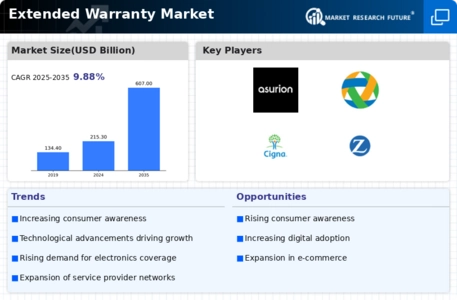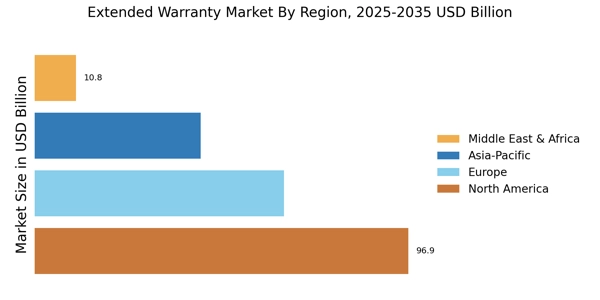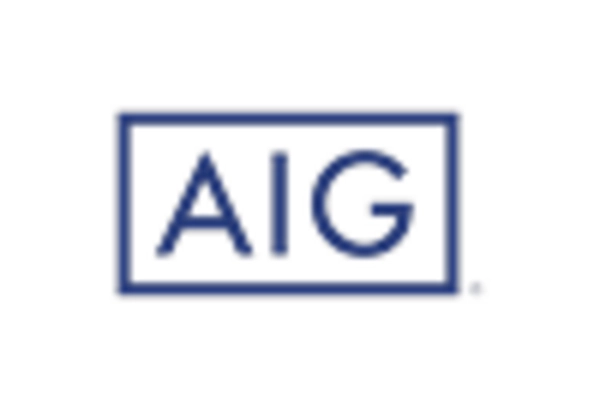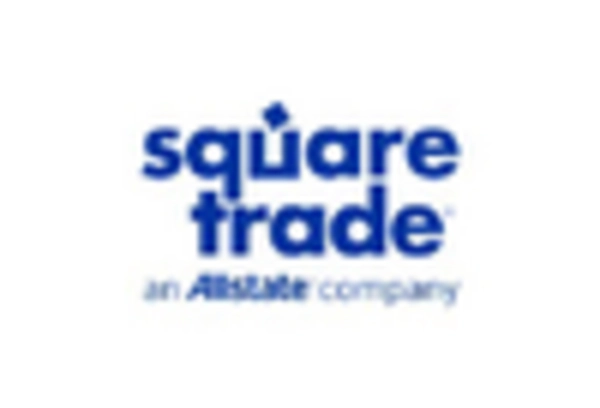Rising Repair Costs
The Extended Warranty Market is significantly impacted by the rising costs associated with repairs and maintenance. As repair expenses for various products, including electronics and appliances, continue to escalate, consumers are increasingly seeking extended warranties to mitigate these costs. In 2025, the average repair cost for consumer electronics is projected to rise by 15%, prompting consumers to consider extended warranties as a financially prudent choice. This trend indicates that as repair costs become more burdensome, the demand for extended warranties will likely increase, thereby driving growth in the Extended Warranty Market. Consumers are recognizing that extended warranties can provide substantial savings in the long run.
Evolving Consumer Preferences
The Extended Warranty Market is influenced by changing consumer preferences, particularly regarding product longevity and maintenance. As consumers become more discerning about their purchases, they are increasingly inclined to opt for extended warranties that offer comprehensive coverage. This shift in mindset is evident in various sectors, including appliances and automobiles, where consumers are willing to invest in warranties that provide peace of mind. In 2025, it is estimated that nearly 60% of consumers will consider extended warranties as essential when purchasing high-value items. This evolving preference indicates a growing recognition of the importance of extended warranties in protecting investments, thereby propelling the market forward.
Increasing Consumer Electronics Sales
The Extended Warranty Market is experiencing growth due to the rising sales of consumer electronics. As more individuals invest in high-value electronics, the demand for extended warranties increases. In 2025, the consumer electronics market is projected to reach approximately 1 trillion dollars, indicating a robust market for extended warranties. Consumers are increasingly aware of the potential repair costs associated with these products, leading them to seek additional protection. This trend suggests that as the sales of electronics continue to rise, so too will the interest in extended warranties, thereby driving the market forward. The Extended Warranty Market is likely to benefit from this correlation, as consumers prioritize safeguarding their investments against unforeseen damages.
Regulatory Changes Favoring Consumer Protection
The Extended Warranty Market is also influenced by regulatory changes that promote consumer protection. Governments are increasingly implementing regulations that require transparency in warranty offerings and ensure that consumers are adequately informed about their rights. These regulations are designed to enhance consumer confidence in warranty products, leading to a potential increase in demand. In 2025, it is expected that new regulations will encourage more consumers to purchase extended warranties, as they feel more secure in their investments. This regulatory environment suggests that the Extended Warranty Market will benefit from heightened consumer trust, ultimately driving market growth.
Technological Advancements in Warranty Management
The Extended Warranty Market is being shaped by technological advancements that enhance warranty management processes. Innovations such as artificial intelligence and machine learning are streamlining claims processing and improving customer service. These technologies enable companies to analyze data more effectively, leading to tailored warranty offerings that meet consumer needs. In 2025, it is anticipated that the integration of technology in warranty management will increase efficiency by up to 30%, thereby attracting more consumers to consider extended warranties. This trend suggests that as technology continues to evolve, the Extended Warranty Market will likely see increased adoption rates, driven by enhanced consumer experiences.


















Leave a Comment